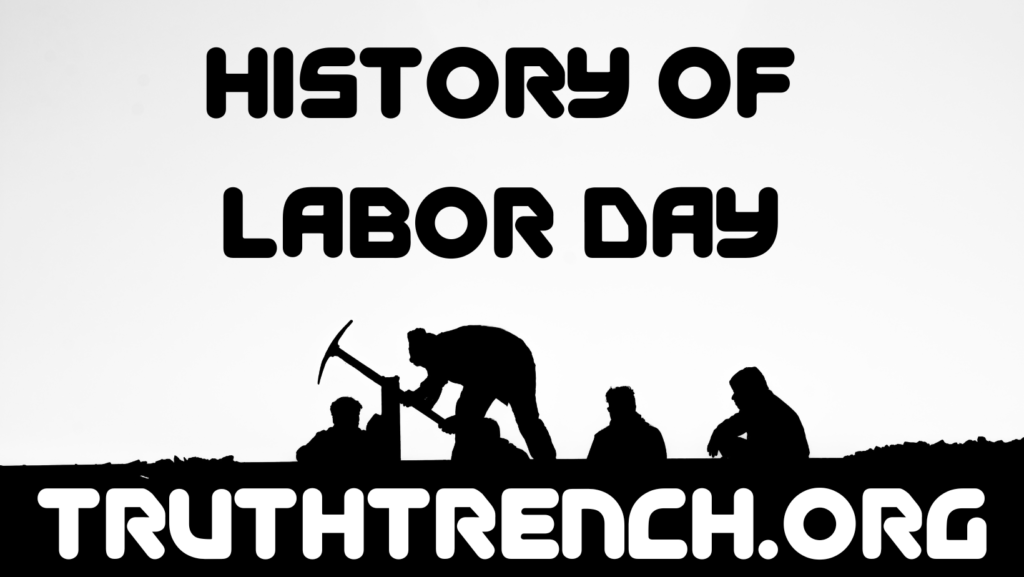Labor Day is often associated with barbecues. It’s the end of summer and school is about to ramp up for youngsters everywhere. You know it is more than just a long weekend to enjoy. It’s a day that celebrates the hard work and dedication of the American workforce. In this patriotic history of Labor Day, we’ll uncover the truth about its origins and the importance of this national holiday. Labor Day had its beginnings in the late 19th century when the American labor movement was gaining momentum. It was a time when many workers toiled under harsh conditions, enduring long hours, low wages, and unsafe workplaces. Workers and labor unions began to organize and demand better treatment and working conditions. One of the most pivotal and tragic events in the history of labor strikes that played a significant role in the creation of Labor Day and subsequent labor legislation is the Haymarket Affair. This violent incident, which occurred in Chicago in 1886, left a lasting impact on labor rights in the United States.
In the late 19th century, workers across the United States were rallying for better working conditions, including an eight-hour workday. On May 1, 1886, a nationwide general strike was called in support of this demand. Thousands of workers in Chicago and other cities took to the streets to protest.
On the evening of May 4, 1886, a peaceful labor rally was held in Chicago’s Haymarket Square to protest police brutality during recent labor strikes. Prominent labor activists and anarchists addressed the crowd, advocating for workers’ rights and an eight-hour workday. The gathering seemed calm, unexpectedly, the police arrived to disperse the crowd. As the police moved in to break up the rally, a bomb was thrown into the crowd, resulting in chaos and violence. The explosion killed several police officers and civilians and injured many more. The authorities responded with a heavy-handed crackdown on labor activists, anarchists, and immigrants, whom they perceived as threats.
The Haymarket Affair had a profound impact on labor relations and legislation in the United States. In its aftermath, eight labor activists were arrested and put on trial for their alleged involvement in the bombing. Despite a lack of concrete evidence linking them to the act, seven of the accused were sentenced to death, and one was given a lengthy prison term.
The Haymarket Affair galvanized the labor movement and led to widespread calls for workers’ rights and fair treatment. In 1887, Oregon became the first state to officially recognize Labor Day as a public holiday. This acknowledgment soon spread to other states.
In the wake of the Haymarket Affair and growing public support for workers’ rights, the push for labor legislation gained momentum. The eight-hour workday, which had been a central demand of the labor movement, was gradually adopted by many industries and states.
The violent events of the Haymarket Affair were tragic, but they played a pivotal role in shaping labor history in the United States. This tragic incident, along with the broader labor movement, contributed to the eventual establishment of Labor Day as a national holiday and the enactment of labor legislation aimed at improving the working conditions and rights of American workers.
The Homestead Strike was a significant labor conflict that took place in 1892 at the Homestead Steel Works in Homestead, Pennsylvania. It was a pivotal event in the history of labor relations in the United States. The strike erupted when the management of the Carnegie Steel Company, led by industrialist Andrew Carnegie and plant manager Henry Clay Frick, attempted to break the Amalgamated Association of Iron and Steel Workers union at the mill.
The conflict culminated in a violent confrontation between striking workers and Pinkerton detectives hired by the company. After a day-long battle, the Pinkertons surrendered, and the Pennsylvania National Guard was called in to restore order. The strike ultimately failed, leading to the defeat of the union and a decline in labor union power in the steel industry.
The Homestead Strike is remembered as a symbol of the struggles and tensions between labor unions and corporate interests during the late 19th century. It had far-reaching implications for the labor movement in the United States and remains a key event in the history of workers’ rights and industrial disputes.
The Pullman Strike of 1894 is one pivotal moment in the history of Labor Day. Workers at the Pullman Palace Car Company in Chicago went on strike to protest low wages and unfair labor practices. The strike paralyzed the nation’s railway system, and it became violent, which lead to the intervention of the U.S. government.
In response to the unrest and violence, President Grover Cleveland and Congress moved to reconcile with the labor movement. Labor Day was officially established as a federal holiday on the first Monday of September in 1894. It was meant to be a day dedicated to recognizing and honoring the American worker’s contributions to the nation’s prosperity.
Since its inception, Labor Day has been a time for Americans to come together and celebrate their hard work and achievements. Parades, picnics, and community gatherings have become traditions, and it’s a time when families and friends unite to enjoy the fruits of their labor.
Labor Day is not just about a day off from work or school; it’s about appreciating the laborers who built this great nation. It’s about recognizing the importance of workers’ rights and fair labor practices. It’s a reminder that when people come together and stand up for what is just, they can bring about positive change.
As we enjoy our Labor Day celebrations, let’s remember the true history and meaning behind this patriotic holiday. It’s a day to honor the hardworking men and women who have made America the land of opportunity. It’s a day to stand up for workers’ rights and fairness in the workplace. So, let’s raise our flags and our hearts in appreciation of the labor that built and continues to strengthen this great nation under God.

